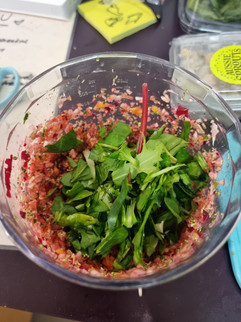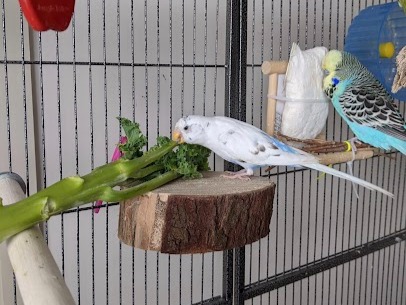The key to a good diet is variety and moderation. For example, Spinach may be healthy, but only eating that everyday is not only boring but can cause serious health issues. There are various ways to ensure your pet is getting the enrichment and nutrients they need, and here are the basics.
The main diet options for grass eating birds such as Budgerigars and Canaries are:
A high quality dry seed blend and vegetables
Chop mix, high quality pellets and a high quality dry seed mix
A mix of (1) and (2)
Treats: millet spray, hemp seed, diced nuts, fruit
Supplements: dried flowers, insects, eggs, coconut, chia seeds, quinoa, linseeds
And I will also briefly touch on feeding parrots such as my Hahn's Macaw and Indian Ringneck, the main things you will need are:
High quality pellets
Chop mix
Treats: nuts, small parrot seed, fruit
Supplements: dried flowers, insects, eggs, coconut, chia seeds, quinoa, linseeds
And how often do you need to prepare food?
Monthly - large batches of chop mix frozen Or
Every 3-4 days - smaller batches that can be stored in the fridge Or
Daily - this is what I do most of the time
So lets get into it!
Why not just feed seed?
Vitamin A deficiency and Fatty Liver Disease are two very common issues that present at the vet each year. Diet is a huge contributor to good health, which is why it is extremely important to consider what species you own, and their wild diet, but also understanding how companion birds differ from wild variants of the same species. For example - many people say that budgies eat seed in the wild, so it would be fine for them to only eat that in captivity; however, people often forget that budgies fly incredible distances each day to help convert that food into energy and that foraging for seed in the wild is much more difficult that having an entire bowl presented to them. So how can we engage our birds in their natural behaviours AND not over feed them?

Why do I do it daily?
Most days I wake up around 6:30am to prepare food for my 11 birds, and the occasional foster birds in my house. The reason I do not make frozen batches is not because it is not a fantastic idea, but because my extremely fussy budgies decided (suddenly) a year ago they will not eat defrosted chop.

Breakfast:
So in the morning, I will generally make them a chop that consists of at minimum 6 different vegetables, dark leafy greens, and defrosted lentils. I keep about 10 - 12 different types of fresh vegetables in my fridge so they get something slightly different each day, and they also get a scoop of dried flowers, linseeds, chia seeds, chilli flakes and coconut mixed in the chop occasionally. A couple times a month I will also add crushed dried mealworms or give them a side omelette with shell.
The budgies and canaries also get a scoop of the Harrison's Superfine Lifetime Pellets on top of their chop mix, this is because I cannot possible provide them with every single essential vitamin and mineral they need every single day with just chop mix. The budgies also get a bowl of leafy greens separate to chew on, some will even bathe in them. The larger parrots in the house are an Indian Ringneck, a Hahn's Macaw and an Alexandrine, these birds get the same chop mix, but every second day they also get mashed sweet potato and store brought sprouts or chickpeas.



Dinner:
In the evening, the budgerigars and canaries get a small amount of seed just before bed because at the end of the day they are grass birds, and deserve to have some seed. But it is important that your seed blend is high quality and low fat. The seed mix we use at home is the Avigrain Budgie Green 5kg + Plain Canary Grass Seed 2kg + Greens n Grains (native grass seed) 4kg. This mixture ends up with less millet and oats (the fattier seeds) and more of the lower fat seeds (canary grass) and has high nutritious, low fat native grass seed they would have in the wild. At night, the IRN gets the Vetafarm Nutriblend pellets as she will refuse to eat any other pellets, the Hahn's and Alexandrine* get the Harrisons Lifetime Fine Pellets. *Please note that the Alexandrine is very new to us, so we have no fine tuned his diet preferences yet.



Treats:
In terms of treats, our budgies will get millet spray or seed sticks usually only as a treat when they're travelling, at the vet or unwell. We also use millet as a training treat. The medium parrots get nuts (almond, pine, walnut) and small parrot seed only when training or for foraging.
Frozen chop:
If you want to make a large batch of chop, we recommend using at least 20 - 30 ingredients to ensure a well balanced meal, since they will be eating this same mix for a month. Fruit doesn't freeze as well, so it is good to add that fresh when it is defrosted. You can add cooked quinoa, rolled oats and chia seeds to help soak up moisture in defrosting chop as well.
Cooked Ingredients:
We pre-cook and freeze batches of sweet potato, chickpeas, lentils, quinoa and chickpea pasta that can be defrosted each morning.
List of safe Ingredients with higher Vitamin A content:
Broccoli
Carrots
Capsicum (especially red)
Chilli
Kale
Pumpkin
Spinach
Squash
Sweet Potato (Cooked)
Mango
Cantaloupe
Dried Apricots
Other household favourites:
Radish
Snow or Sweet Peas
Silverbeet
Turnip
Zucchini
Chillis
Corn
Dark Lettuces
Bok Choy/Choy Sum
Celery Leaves
fennel
Rocket
Spinach
Beetroot
Apple
Blueberry
Strawberry
Melon
Peach
Grape
Coconut
There is SO SO much to discuss about diet, so this is just one post. I will certainly come back and discuss each bit in more detail another day.
























Comments